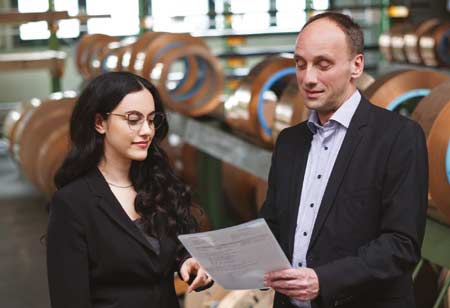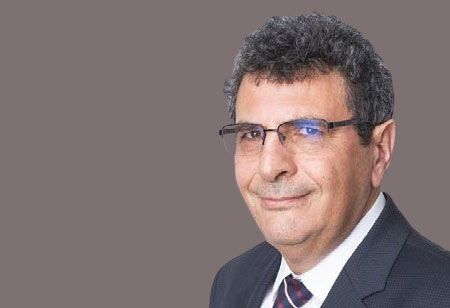THANK YOU FOR SUBSCRIBING

High-Performance Materials and Processes for Complex Applications with Proven Sustainability
Dr. Andreas Frehn, Director Technology & Innovation and Technical Marketing Emea, Materion

 Dr. Andreas Frehn, Director Technology & Innovation and Technical Marketing Emea, Materion
Dr. Andreas Frehn, Director Technology & Innovation and Technical Marketing Emea, MaterionRecognizing Dr. Andreas Frehn’s extensive expertise in technology and innovation at Materion, this exclusive feature offers invaluable insights into the challenges of advancing high-performance materials and processes and strategies for leveraging sustainable solutions to support key global megatrends like clean energy, advanced mobility, and connectivity.
In strategic foresight, megatrends refer to long-lasting and system-changing developments with a global character and a duration of several decades. They affect almost all areas of life and can manifest themselves, for example, in transformed consumption patterns, values or technologies. Current megatrends include connectivity, advanced mobility and clean energy and represent a meaningful part of the research activities at universities and companies. Innovations in the context of these megatrends are based not only on technological progress, but also on innovative, high-performance materials. Twothirds of technical innovations, regardless of the economic sector, are directly or indirectly attributable to new materials. Crossing industry and scientific boundaries is a key factor for generating groundbreaking results and makes materials science and development a key and cross-sectional technology. The influence of digitalization and artificial intelligence is further driving this progress and is creating additional opportunities.
At the same time, the topics of climate and resource protection must be considered. In the field of materials production, the sustainable and economical mining of raw materials should be mentioned. Furthermore, the choice of the right production process is of great importance. In the steel industry, for example, the trend towards the CO2-optimized electric steel process can be observed. In addition, steel manufacturers are working on processes that use hydrogen instead of coal. Often, the semi-finished products are shaped as close as possible to the final component geometry to reduce the process steps, and thus, helps to decrease the machining efforts. New production processes, such as additive manufacturing, make it possible to break out of the traditional manufacturing routes and enable almost direct production of the final component without having to cast, roll or forge.
Advancing Sustainability and Performance through Innovative Materials
In the final product, the materials should have a positive impact on certain properties so that an increase in longevity, a reduction in component size or significant weight savings can be achieved in the application. Nowadays, the approach is often to use materials exactly where their special properties are needed and thus to utilize their greatest benefit. And finally, the topic of recycling will continue to grow in importance. For metals or glass, very high recycling rates are already being reached today. However, the recovery of materials from certain products (e.g. electrical components) is sometimes complex and leads to challenges in the recycling process.
“Two-thirds of technical innovations, regardless of the economic sector, are directly or indirectly attributable to new materials”
Materion has been dealing with materials and related topics for more than 100 years. In doing so, the company has always been guided by megatrends and accompanied them with suitable solutions. And this is still valid and relevant for today's megatrends mentioned above. The history of the company is closely linked to the element beryllium, which is mined in the company's own mine in Utah (USA) and further processed in the various plants. Beryllium is characterized by a very low density, high stiffness and special thermal properties and is used either as an almost pure alloy or as an alloying element for copper, aluminium and nickel-based alloys. In the past (but also today), beryllium has played a major role in various space missions, in defense applications, but also in medical X-ray equipment or in advanced energy generation such as fusion technology. FLiBe, which is a molten salt made from a mixture of lithium fluoride and beryllium fluoride, serves as a nuclear reactor coolant and solvent for fertile or fissile material in visionary atomic reactor designs.
By mixing beryllium with beryllium-oxide or aluminium, it is possible to almost retain the outstanding properties of pure beryllium while benefiting from the (in the case of Al) lower costs and improved machinability of the paired metal. In addition to the already mentioned applications, components from these materials are used in the field of thermal management. Beryllium as an alloying element in copper ensures the highest strength values of all commercially available copper alloys, in combination with the well-known properties of copper such as thermal or electrical conductivity. Recent studies have also demonstrated that these alloys, unlike some high-strength steels, are particularly stable in hydrogen atmospheres, which enable hydrogen applications in the megatrend clean energy. Aluminium-based metal matrix composites alloys, which are using silicon-carbide or silicon as alloying components, complete the material portfolio in the field of lightweight construction with their higher strength and stiffness compared to conventional aluminium alloys.
The relatively new area of tantalum and niobium alloys supports the megatrend of connectivity and, due to its high corrosion resistance, also provides new applications in the fields of chemical plant construction and, because of its temperature resistance, also applications in the aerospace industry.
In addition to the traditional powder and melt metallurgical manufacturing processes, advanced processes are also used to provide the materials for advanced applications. As an example, roll bonding can be used to produce material combinations that combine the properties of different materials in one strip. Such cladded materials enable technologies supporting the megatrends advanced mobility and clean energy. Additionally, Materion is also active in the technology of additive manufacturing, which can result in a broader design flexibility and a shorter process chain, leading to a reduction in delivery time and costs.
In addition to technical progress in the field of materials and processes, the sustainability factor has gained great importance. For example, the topics of responsible sourcing of minerals and the definition of and compliance with highest standards (also by external vendors) are as critical as the reduction of CO2 emissions. As a result of these efforts, Materion was listed among USA TODAY America's Climate Leaders 2024. And finally, continuing developments in advanced materials and their right selection make new applications in the various megatrends possible and ensure that the produced components show the highest performance, efficiency and longevity.
Read Also























ON THE DECK